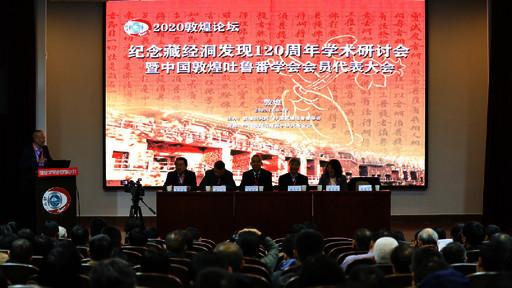
. > WHAT'S NEW > CONFERENCES
Seminar reviews 120 years of Dunhuang studies
Author : Source : Chinese Social Sciences Today 2020-12-25

Scholars reflect on the journey and achievements of Dunhuang studies over the past 120 years at a recent forum in Dunhuang, Gansu Province. Photo: FILE
ZHU YI DUNHUANG—A forum on the 120th anniversary of the discovery of Cave 17, also known as the Library Cave, at the Mogao Grottoes was recently held in Dunhuang, Gansu Province.
Scholars conducted in-depth discussions of Cave 17, cultural relics found in the cave, and the model for the digital return of overseas cultural relics.
On June 22, 1900, the discovery of Cave 17 triggered the establishment and development of a discipline. More than 50,000 documents and paper or silk paintings were found in the cave. The literature includes religious texts, Confucian classics, historical records, philosophical writings, official or private documents, and writings in ethnic minority languages. These miscellaneous works cover the fields of ancient history, geography, politics, economy, literature, language, folklore, music, and science and technology.
Cave 17 is one of four major archaeological discoveries in China in the early 20th century, said Zhao Shengliang, president of the Dunhuang Academy China. The cultural relics at the Dunhuang Grottoes embody cultural integration between the 4th and 14th centuries, exemplifying the openness, inclusiveness, and broadness of the Chinese civilization. They contain immeasurable historical, artistic, scientific and technological, social, and cultural values.
Cave 17’s discovery has unveiled the mysteries of Dunhuang’s culture, said Zhao Guoying, vice president of the Palace Museum. Dunhuang represents the largest surviving, longest lasting, richest in content, and best preserved art treasury in the world. As a rich archive of human civilization, it provides precious historical data for exploring the politics, economy, military affairs, culture, and art of various ethnic groups in ancient China. Dunhuang’s culture showcases China’s cultural confidence in drawing upon others’ strengths, exhibiting this nation’s indomitable cultural spirit.
Dunhuang’s domestic study experienced a sad chapter in history. Around 1900, the cultural relics of Cave 17 were forcibly moved to more than ten overseas countries, including the UK, France, Russia, and Japan.
According to Zhao Shengliang, since the discovery, Cave 17’s cultural relics attracted significant attention from domestic and international scholars, soon forming a world-renowned comprehensive discipline—Dunhuang studies. This greatly expands people’s understanding of ancient Chinese history, culture, art, and the EastWest cultural exchanges along the Silk Road. However, domestic Dunhuang studies were, for historical reasons, in a backward state.
After the reform and opening up, China made remarkable progress in Dunhuang studies, becoming a veritable research hub of Dunhuang studies, and fundamentally changing the research pattern for this discipline. In the 21st century, Dunhuang studies advanced in the fields of historiography, religious studies, ancient literature, linguistics, art, and the history of science and technology. At the same time, in-depth research of Dunhuang Grottoes has inspired modern artistic creations such as paintings, sculptures, architecture, calligraphy, music, dance, and even costume design.
Wang Guoqiang, deputy director of the publicity department of Gansu Provincial Party Committee, noted that over the past 120 years, with the concerted efforts of scholars worldwide, Cave 17’s cultural relics have been gradually organized and published, revealing their value. Especially with the government’s high attention, Chinese scholars rose up and completely changed the research situation of “Dunhuang Grottoes in China, but Dunhuang studies abroad,” into that of “Dunhuang Grottoes in China, and Dunhuang studies in China and throughout the world.”
In light of the great rejuvenation of the Chinese nation, as well as the profound changes unseen in a century in the world, Dunhuang studies, as a famous international discipline, bears the glory and dream of the ancient Silk Road, and shoulders the mission of serving the joint construction of the Belt and Road. With broad research prospects, Dunhuang studies is responsible for deepening understandings of China and its culture, said Chen Yuzhu, deputy director general of Gansu Provincial Cultural Relics Bureau.
Hao Chunwen, president of the Chinese Dunhuang Turpan Society, introduced the major work plans for Dunhuang research in the next 5–15 years, which involves eight tasks that will soon be implemented, including the publication of a new complete collection of Dunhuang Grottoes, and the establishment of a global resource sharing platform on Dunhuang literature.
Domestic researchers should continue to maintain their current pioneering and enterprising research trends. Meanwhile, international scholars are greatly welcomed to join in the research, in a joint effort to make breakthroughs in Dunhuang studies, Hao suggested.
It is the historical mission and responsibility for scholars to inherit, innovate with, and disseminate the Chinese culture in a new era, vigorously studying and carrying forward the Dunhuang culture, Zhao Guoying concluded.
Ye Shengtao made Chinese fairy tales from a wilderness
Ye Shengtao (1894–1988) created the first collection of fairy tales in the history of Chinese children’s literature...
-
How northern ethnicities integrated into Chinese nation
2023-09-18
-
Mogao caves
2023-09-12
-
Mogao Grottoes as ‘a place of pilgrimage’
2023-09-12
-
Time-honored architectural traditions in China
2023-08-29
-
Disentangling the civilizational evolution of China
2023-08-28
-
AI ethics in science fiction
2023-08-23













 2011-2013 by www.cssn.cn. All Rights Reserved
2011-2013 by www.cssn.cn. All Rights Reserved